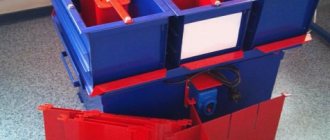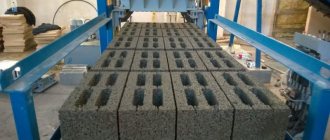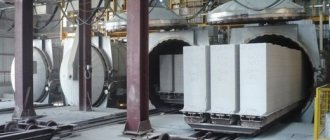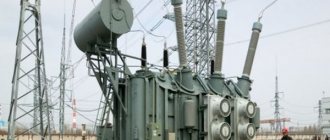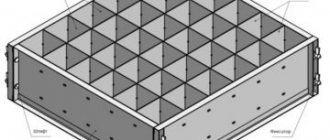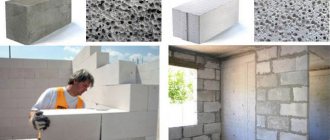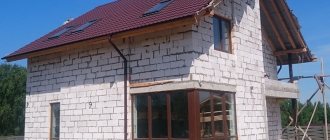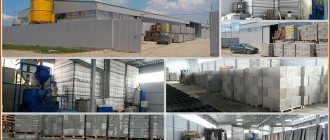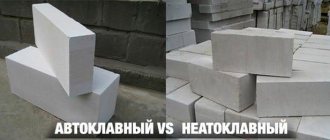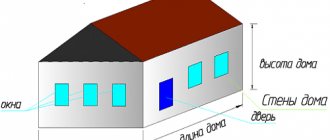General description of the material
Foam concrete
Foam concrete is concrete that has a cellular structure. These properties are achieved by the presence of closed air bubbles in the thickness of the material. Therefore, foam concrete blocks have low density and thermal conductivity.
They are very often used both as thermal insulation materials (grades D200-D500), and structural and thermal insulation materials (grades D600-D800) or structural (D900-D1600).
Foam concrete is especially often used in low-rise construction or in the construction of interior partitions. It is very well processed and can be trimmed to suit the required building parameters. Foam concrete blocks are manufactured in accordance with standard dimensions - usually 200x300x600 mm or 100x300x600 mm.
When using foam blocks in private construction, you can get the following:
- low cost of material;
- excellent thermophysical characteristics;
- ease of processing and installation;
- light weight of the blocks, which does not create additional load on other structures;
- environmental friendliness of the material.
The disadvantages of foam concrete include its low strength, ability to absorb moisture from the environment, and significant shrinkage.
Features of foam block production
In order for the profit from the production of foam blocks to be high, this issue should be taken seriously. First of all, you need to choose a method of manufacturing the material - classic or autoclave. In the first case, it is necessary to prepare a regular cement mortar, into which air is supplied using a foam generator. After thorough mixing, the mixture enters the prepared molds, where it reaches its design strength.
When using the autoclave method, all components of foam concrete are mixed under significant pressure. The finished solution is fed into the molds through a nozzle.
There is also another technology for producing this material - mixing dry components with subsequent mineralization. It is quite complex, so it is mainly used in mass production.
Production
The production of foam concrete, despite the relatively low cost of factory-made foam blocks, is very tempting to produce them at home or in a mini-factory.
There is a common misconception that foam concrete can be produced by simply adding a foaming agent to a standard concrete mix. This is wrong.
The production of foam blocks from foam concrete is carried out mainly by two methods. The classic method is to prepare a cement mixture (recipes are given below). Foam is supplied to the finished mixture from a foam generator and after mixing, the foam concrete is poured into molds. Using the autoclave method, all components are thoroughly mixed in a mixer under pressure. The resulting mixture is squeezed through a nozzle into the prepared mold. Technologies based on mixing dry components are usually used in mass production.
Form for foam blocks
For the production of foam concrete, Portland cement of a grade not lower than M400 (preferably M500), sifted and washed river sand, and a foaming agent are used. Sometimes additives are added to the concrete mixture to accelerate setting (for example, liquid glass) and also improve the structure of concrete (calcium chloride or calcium nitrate). Sand should be used in small fractions, since large particles quickly settle (sediment), which significantly reduces the quality of the product.
Necessary equipment
Necessary equipment for the production of foam blocks at home:
- concrete mixer. You can also use a special installation for the production of cellular concrete. It involves a complex unit, which includes a pressure mixer, an adapter for a sleeve through which the prepared solution is poured into molds;
- compressor. This installation is necessary for supplying compressed air to other units - a steam generator device, a mixer for supplying the finished solution;
- steam generator. This unit produces a special fine-pored foam, which consists of water, air and a special foaming agent;
- form. This equipment for the production of foam concrete can be made independently from plywood, chipboard or regular edged boards.
Foam generator for foam concrete
Equipment advantages
Durable bearing unit.
The entire range of installations for the production of foam concrete is equipped with a bearing unit with a pressure compensation chamber. This type of bearing assembly should be used in mixers that apply excess pressure. Only such bearings are used in professional construction equipment of domestic and foreign production, which use compressed air to unload the mixture. This unit outperforms all types of bearing units, including remote bearings over a considerable distance.
Reliable drive
About 10 years ago, in mixers of 0.5 m3 and more, SSM-Holding (GK Severstroymaterialy) switched to a pulley-belt drive using a spur gearbox connected to the shaft through a pin-sleeve coupling. The goal of the transition was to bring the number of complaints closer to “0”. This is an expensive drive, where the gearbox has two stages of protection:
— Belts — Clutch
An acceptable economy class drive is a pulley-belt-gear drive for small mixers up to 0.3 m3. We do not pursue low costs - we offer a high-quality product. We use only reliable materials and technologies in our production!
How much do you need to invest to start a business?
If you plan to start producing foam concrete blocks only for your own needs, you can get by with less powerful equipment. In this case, you can buy a regular concrete mixer, the average cost of which is 3,000 rubles. It is also necessary to additionally purchase a foam generator with a compressor for 20 thousand rubles. If you plan to set up a business producing foam blocks, it is more advisable to buy a ready-made set of equipment and molds. In this case, you can use not only new units, but also used ones (in good condition).
Ready-made foam concrete installations are very easy to use. They occupy a small area - about 2.5-5 square meters. m depending on power and standard equipment. This complex also includes a grid for loading bulk materials, a vacuum gauge, a rotary pump, a water meter, hoses, and a control cabinet. For a home business, the PBU-300 model would be ideal, the average price of which is 130 thousand rubles.
Installation of PBU-300
It has the following characteristics:
- working volume is 300 l;
- productivity – 0.9 cubic meters. m/hour;
- power – 2.2 kW;
- weight – 0.38 t;
- dimensions – 1.7x1.5x0.85 m.
Business plan for the production of foam blocks
The production of foam blocks is one of the most profitable types of business in the production of building materials. This business is characterized by a minimum entry threshold compared to other types of business, high and stable demand for products, as well as simple production technology.
The most important factor in the production of foam blocks, which will determine the cost and quality of the product, is technology.
Today, the following technologies are used in the production of foam blocks:
- Barotechnology
- Technology that uses a foam generator
Barotechnology is one of the cheapest production methods. Production does not require the purchase of expensive equipment and the production process is as follows:
- All materials are supplied to the container: cement, sand, water, foaming agent, various additives
- Next, the whole mixture is mixed
- The next step is to pour the mixture into injection molds and harden.
The advantages of this technology include fast production speed and low cost. The disadvantages include: low product quality due to the large amount of water used and the formation of large pores inside the block.
The next technology uses a foam generator to produce foam blocks. The use of this device allows you to mix all components in the correct dosage, which has a positive effect on the strength of the foam blocks.
Initially, with this technology, dry components are first mixed - cement, sand and other additives, and only then water with other additives is added. Next, the entire mass is mixed, into which special technical foam is supplied from the foam generator. This allows for even mixing.
The advantages of this technology include high quality products. The disadvantages include high capital costs and high production costs.
It is also very important to correctly mold the foam block. Its geometry will also depend on this. Molding is carried out using two technologies: injection and cutting.
Injection molding involves creating blocks in special cassette containers. The disadvantage of this technology is the possible discrepancy in the geometry of the foam blocks.
In turn, cutting technology involves pouring the mixture into one large formwork and then cutting it into smaller parts. With this method, it is very important to comply with the timing of cutting foam blocks.
This business plan is focused on creating a more expensive production method, since in this case the products will meet all requirements and GOSTs.
To open, you will need to purchase the following equipment:
- Loader
- Pressure setting
- injection mold
- Foam generator
- Cutting machine
- Block drying apparatus
- Mixing apparatus
- Compressor
- Vibrating screens
This equipment will fully support production activities and carry out the entire production process.
In addition to the equipment, you will need to rent a fairly large production workshop. Its area is about 500 m2. It is best to select a production workshop outside the city at old industrial facilities. This will allow you to significantly reduce costs.
In addition to organizational issues, the business owner needs to ensure normal working conditions (in accordance with the Labor Code), since this production is one of the dirty ones and has an impact on human life. Be sure to take care of fire safety.
What to do with forms?
You can make molds for foam blocks yourself, but it is very difficult. It is very important to monitor the accuracy of all parameters so that the resulting material has ideal dimensions. Therefore, for a home business, it is best to find used molds. Their cost will depend on the capacity and material from which they are made. On the building materials and equipment market you can find approximately the following prices:
- steel molds (36 pieces), where the cell size is 600x300x200 mm - 32 thousand rubles;
- steel molds (22 pieces), where the cell size is 600x300x200 mm - 10 thousand rubles;
- plywood molds (22 pieces), where the cell size is 588x300x188 mm - 6 thousand rubles;
- one plastic mold measuring 390x190x288 mm - 250 rubles.
Forms for foam blocks
Foam block production lines
Until the mixture is poured into molds, both technological methods, casting and cutting, have identical technology and equipment for the production of foam blocks.
The list of basic equipment is as follows: a hopper or tub for mixing ingredients, a foam generator, a dispenser, and molds.
Instead of a hopper, a pressure mixer can be used, which can be called a machine.
In such a mixer, the components are not only mixed, but under pressure the finished solution is delivered directly to the molds, which can be located at a distance of up to 115 m and at a height of up to 40 m.
In this case, you need a compressor with a set of hoses for air supply, and hoses for transporting the solution.
The RSG-500 installation is a machine for the production of foam blocks and a combining foam generator with a hopper in which foam is whipped, a solution is prepared, stirring occurs again and the finished mixture can be immediately supplied to the molds.
If an entrepreneur decides to prepare blocks in compliance with the exact dimensions and geometric shape, with a minimum of defects and waste, then he needs a machine for cutting foam concrete, one of the representatives of which can be the cutting complex “RK-3” for sawing foam concrete masses. Of course, the ideal compact, comprehensive equipment is a line for the production of foam blocks. Such equipment does not require the use of physical force of workers; it is very productive; ready-made solution is prepared per shift, depending on the parameters of the line, in a volume of 40 m3 to 80 m3 per shift.
Automation controls all technology processes, from dosing components to controlling mass density, since foam blocks can be made with different volumetric weights.
Cost of manufactured foam concrete blocks
For example, to build a house you need 20 cubic meters. m of foam concrete blocks. To produce them, you need to buy a concrete mixer, a foam generator and plywood molds. In general, you need to spend about 29 thousand rubles on the purchase of all equipment.
Cost of 1 cubic meter m of blocks is determined by all the necessary costs for their production :
- materials – cement, sand, foaming agent. To get 1 cu. m of finished products you need to spend 720 rubles;
- electricity – 11.25 rubles;
- equipment costs - 29,000/20 = 1,450 rubles.
It turns out that the cost of production is 1 cubic meter. m of foam blocks are 2181 rubles. The final cost of the material can be reduced by purchasing all materials in large quantities at a wholesale price and renting out the equipment after construction is completed.
Professional equipment
When selecting equipment for the production of foam blocks, you should pay attention to mobile mini-factories or stationary conveyor lines.
Mini-factory
The first type of device includes a concrete mixer with an adapter, a compressor, a steam generator, a working platform and a dispenser. When using such a mini-plant, the finished solution is manually distributed into molds, and after setting, it is removed from them and sent to an autoclave. After final drying, the blocks are completely ready for use. This equipment is delivered to the site as an integral complex. It is easy to install and does not require commissioning.
As a result of the production of blocks using mobile mini-factories, material of average quality is obtained. Also, the disadvantages of this equipment include the significant consumption of foaming agents. To obtain a product with optimal characteristics, you need to carefully approach the formulation of the blocks. If you select the necessary components incorrectly, the material will turn out to be of poor quality.
Stationary conveyor lines differ from previous equipment in their high power. It is capable of working around the clock, providing a capacity of 5-12 cubic meters. m/hour.
Aerated concrete production line
Typically, such conveyor lines are equipped with the following units:
- a mixing complex, which is additionally equipped with a pneumatic seal and a pump;
- foam generator with compressor;
- water dispenser, which is equipped with an automatic control system;
- dispenser for binding materials;
- conveyors for sand and cement;
- Remote Control;
- vibrating sieve
Considering all the features of the production process for the production of foam concrete blocks on both a small and large scale, it is clear that this is a very profitable business. This material is popular in the market, so there will always be demand for it among buyers.
Foam block production technology
The technological process for producing blocks does not present any complexity. You need to perform the following operations:
- prepare foam;
- make a solution of sand, cement and water;
- add foam to the solution, stir until a homogeneous mass is obtained;
- Pour the prepared solution into prepared forms;
- allow the foam-containing solution to gain strength;
- remove the finished blocks from the molds.
The above technology is called injection molding.
You can do without the use of molds; then the prepared solution is poured into a volumetric cassette, where the block mass reaches the strength required by the technology.
After which a special device with vertical and horizontal strings cuts the mass into blocks.
This technology for the production of foam blocks makes it possible to obtain high accuracy of block dimensions, with tolerances of 1 mm. To cut the array into 16 blocks with dimensions of 200x300x600 mm, the unit will take no more than 7 minutes. It is possible to obtain blocks of other sizes.
